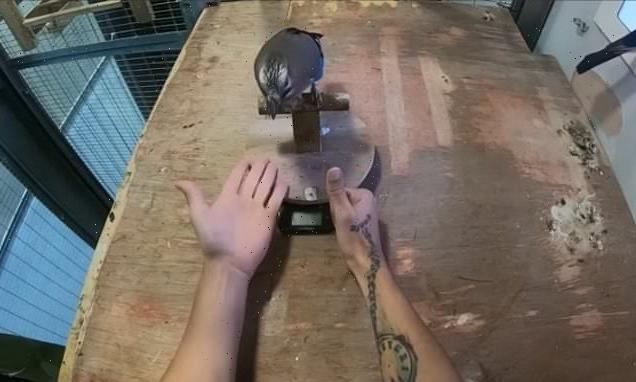
Not so bird brained after all! Avians are less easily fooled by sleight-of-hand magic tricks than humans, study shows
- Scientists at Cambridge performed magic tricks on jays and human volunteers
- The experts performed three tricks – palming, the French drop and the fast pass
- The birds performed better on two out of the three tricks compared to humans
Birds are less easily fooled by sleight-of-hand magic tricks than humans, a new study into avian perception reveals.
Researchers at the University of Cambridge performed three variations of magic tricks on six Eurasian jays (Garrulus glandarius), as well as 80 human volunteers.
Overall, the bird species was better able to suss two of the three tricks than humans were, the experts found – although humans and jays performed about the same on the third trick.
Until this study, little had been known about how non-human animals perceive ‘intricate techniques of deception’ involved in magic tricks, the authors say.
They believe studying animal reactions to tricks can unlock secrets about how their brains function.
Scroll down for video
THE THREE TRICKS
– Palming: Involves hiding an object in the palm while pretending the hand is empty.
– The French drop: Involves pretending to pass something from one palm to the other, without actually moving the object.
– The fast pass: Involves moving an object between your hands so quickly it’s not witnessed.
The study has been led by Elias Garcia-Pelegrin, a magician and cognitive scientist at the University of Cambridge.
Magic tricks could be a good tool ‘to investigate the non-human animal mind’, he says in an article for The Conversation.
‘The study of how animals perceive magic effects that fool and surprise humans can help us understand how their minds experience the world around them, and whether such experiences are in some way like ours,’ he writes.
‘We performed three different sleight of hand effects to Eurasian jays and human participants and compared their responses.’
The three magic tricks used in the experiments – palming, French drop and fast pass – all involve misleading the observer into thinking an object has or hasn’t been transferred from one hand to the other.
For the experiments with the Eurasian jays, a worm was passed between Garcia-Pelegrin’s hand, which the birds were allowed to eat if they chose the correct one.
Overall, the birds performed better than humans on palming and the French drop, but they were significantly fooled by the third technique – fast pass.
This means that, similar to humans, Eurasian jays are susceptible to magic effects that involve fast movements.
‘Unlike our human sample, which was significantly fooled by all three of the magic effects we performed, Eurasian jays didn’t seem to be fooled by the first two tricks,’ said Garcia-Pelegrin.
‘This could be because jays lack the expectations about hand mechanics that makes us humans liable to these techniques of deception.’
The results are intriguing partly because birds seemed to understand the intricacies of crafty hand movements, even though they don’t have hands themselves.
The birds could possibly have just picked the hand that they last saw the worm in, while humans had the knowledge that they were the subject of a trick, and so may have become more confused and uncertain when making their choice.
Similar to humans, Eurasian jays are susceptible to magic effects that involve fast movements
‘Eurasian jays do not appear to be misled by magic effects that rely on the observer’s intrinsic expectations in human object manipulation,’ Garcia-Pelegrin and his co-authors say in their research paper.
Deception is not totally new to Corvids (birds in the crow family that include the Eurasian jay and other jays, as well as ravens and magpies).
They hide food discreetly in one spot while pretending to hide it in many other places, to confuse food thieves.
‘This clever family of birds use intricate and highly elaborate protection tactics that are comparable to the misdirection used by magicians,’ Garcia-Pelegrin says.
The new study has been published in Proceedings of the National Academy of Sciences.
MAGIC TRICKS COULD REVEAL SECRETS ABOUT ANIMAL MINDS
Researchers at the University of Cambridge argue that magic tricks should be used to help learn more about how the minds of animals work.
In an article in the journal Science, they say ‘the application of magic effects to investigate the animal mind can prompt the comparison of behavioural reactions among diverse species’.
Studying the ways magic tricks fool the brain may explain ‘blind spots’ in perception.
In their paper, the authors suggest the same should be true for animals exposed to magic tricks.
Memorable viral videos in the last few years have showed human-like reactions to magic tricks from primates other than humans.
But efforts should be made to understand what the animals in these videos are actually thinking.
The researchers are turning their attention to other kinds of animals – in their 2021 study, they tested Eurasian jays (Garrulus glandarius) with three sleight-of-hand tricks.
Overall, the bird species was better able to suss two of the three tricks than humans were, the experts found, although the humans and jays performed about the same on the third trick.
Source: Read Full Article
